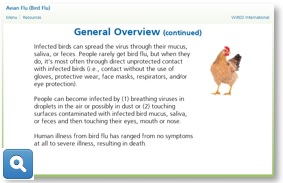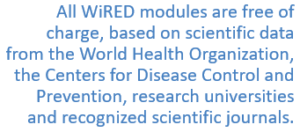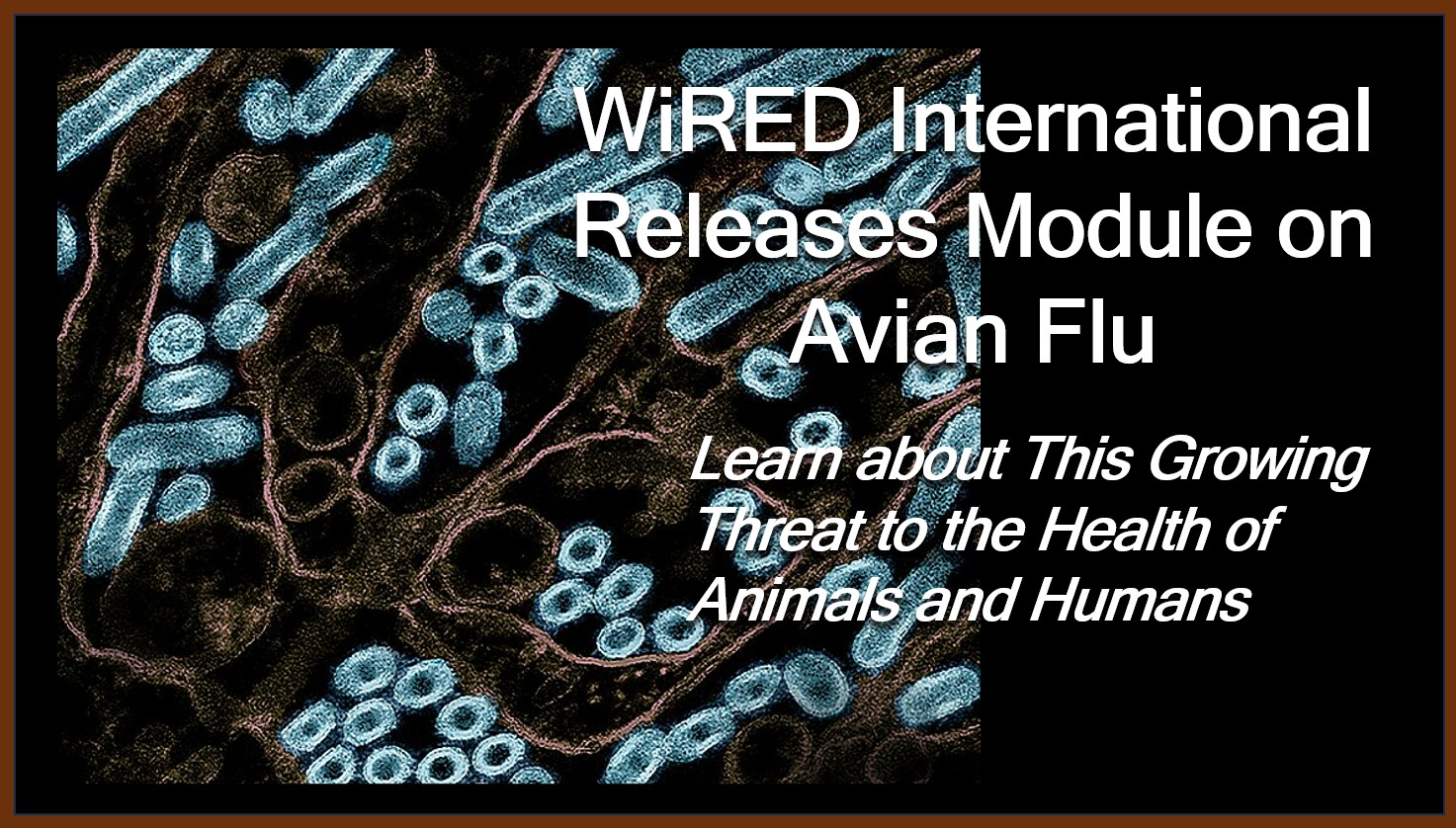Bird Flu – three influenza A (H5N1-bird flu) virus.
National Institute of Allergy and Infectious Diseases (NIAID) image.
By Allison Kozicharow; Edited by Elizabeth Fine
WiRED International has just released an evidence-based training module designed to help community health workers (CHWs) and others working in public health to understand important elements of this rapidly spreading avian flu.
What is Avian or Bird Flu?
WiRED’s new Avian Flu module explains that the infection is caused by certain flu viruses that usually spread between birds. Recently there have been reports of avian flu spreading to some animals (e.g., cows, cats, and dogs), and, although it happens rarely, to people.
 The disease is contracted from avian influenza A viruses, with H5N1 being a particularly concerning strain (among the other strains of H2N5, H5N2 and H7N2). Infected birds can spread the virus through mucus, saliva or feces. People can become infected by breathing in virus droplets, touching contaminate surfaces and then touching their eyes, mouth or nose.
The disease is contracted from avian influenza A viruses, with H5N1 being a particularly concerning strain (among the other strains of H2N5, H5N2 and H7N2). Infected birds can spread the virus through mucus, saliva or feces. People can become infected by breathing in virus droplets, touching contaminate surfaces and then touching their eyes, mouth or nose.
The best way for people to keep safe is to:
- Avoid contact with sick or dead animals,
- Practice proper hand hygiene and food safety practices,
- Use appropriate protective equipment if working with birds or in high-risk environments,
- Consume pasteurized milk and milk products, and
- Maintain regular seasonal influenza vaccinations.
WiRED’s Health Training Programs
WiRED always acts quickly to develop high-quality peer-reviewed, science-based modules on critical health issues that pose a global threat. Previous examples include our training modules on outbreaks such as Ebola, COVID-19, Zika and polio.
 Note that when we added the Avian Flu module to WiRED’s 400+ health education library, we made it accessible through our new Android phone app, available for free at Google Play Store (under HealthMAP). This demonstrates WiRED’s capacity to develop high-quality training material and distribute it worldwide in an instant, through HealthMAP.
Note that when we added the Avian Flu module to WiRED’s 400+ health education library, we made it accessible through our new Android phone app, available for free at Google Play Store (under HealthMAP). This demonstrates WiRED’s capacity to develop high-quality training material and distribute it worldwide in an instant, through HealthMAP.
All WiRED modules are free of charge, based rigidly on scientific data from the World Health Organization, the Centers for Disease Control and Prevention, research universities and recognized scientific journals. Modules are written by medical doctors and go through a rigorous editing and review process before release.
 Community health workers (CHWs) play a key role in avian flu prevention and management in low-resource regions where health professionals are scarce. CHWs provide accurate information about transmission, diagnosis and treatment; monitor their communities; promote safe hygiene and food handling; and make referrals to health authorities.
Community health workers (CHWs) play a key role in avian flu prevention and management in low-resource regions where health professionals are scarce. CHWs provide accurate information about transmission, diagnosis and treatment; monitor their communities; promote safe hygiene and food handling; and make referrals to health authorities.
WiRED will continue to monitor the avian flu in the news media and scientific journals. Knowledge about disease transmission in general from animals to humans is an important part of the One Health approach WiRED folds into our health education programs. The relationship between animals, humans and the environment is vital to preserve the health of all.
 Readers are welcome to download WiRED’s HealthMAP program to their Android devices for free. It allows users to review our catalog of training modules and download modules for offline study, all without cost.
Readers are welcome to download WiRED’s HealthMAP program to their Android devices for free. It allows users to review our catalog of training modules and download modules for offline study, all without cost.
https://play.google.com/store/apps/details?id=com.wiredInternational.wired_app&hl=en_US
Climate Change and Avian Flu
There is scientific evidence suggesting that climate change is contributing to the spread and evolution of avian flu, particularly the H5N1 strain. Climate change affects factors that influence the transmission and persistence of avian flu viruses:
- Migratory patterns: Climate change is altering bird migration routes and timing, potentially leading to new interactions between species and increased virus transmission.
- Temperature and humidity: Changes in temperature and relative humidity affect the survival and transmission of avian influenza viruses.
- Environmental persistence: Warmer winters and earlier springs in North America may allow moisture-reliant pathogens, including influenza viruses, to survive longer in the environment.
- Species distribution: Climate change is causing shifts in the distribution of bird populations, potentially creating new interfaces between wild and domestic birds.
- Viral evolution: Changing environmental conditions may contribute to the emergence of new viral variants.
While more research is needed to fully understand the complex interactions between climate change and avian flu, the existing evidence suggests that climate change is indeed contributing to the spread and evolution of avian flu viruses.
Note: Information in this sidebar was obtained from the following sources:
https://pmc.ncbi.nlm.nih.gov/articles/PMC2709837
https://news.asu.edu/20190522-asu-researchers-evaluate-impact-climate-change-avian-flu


